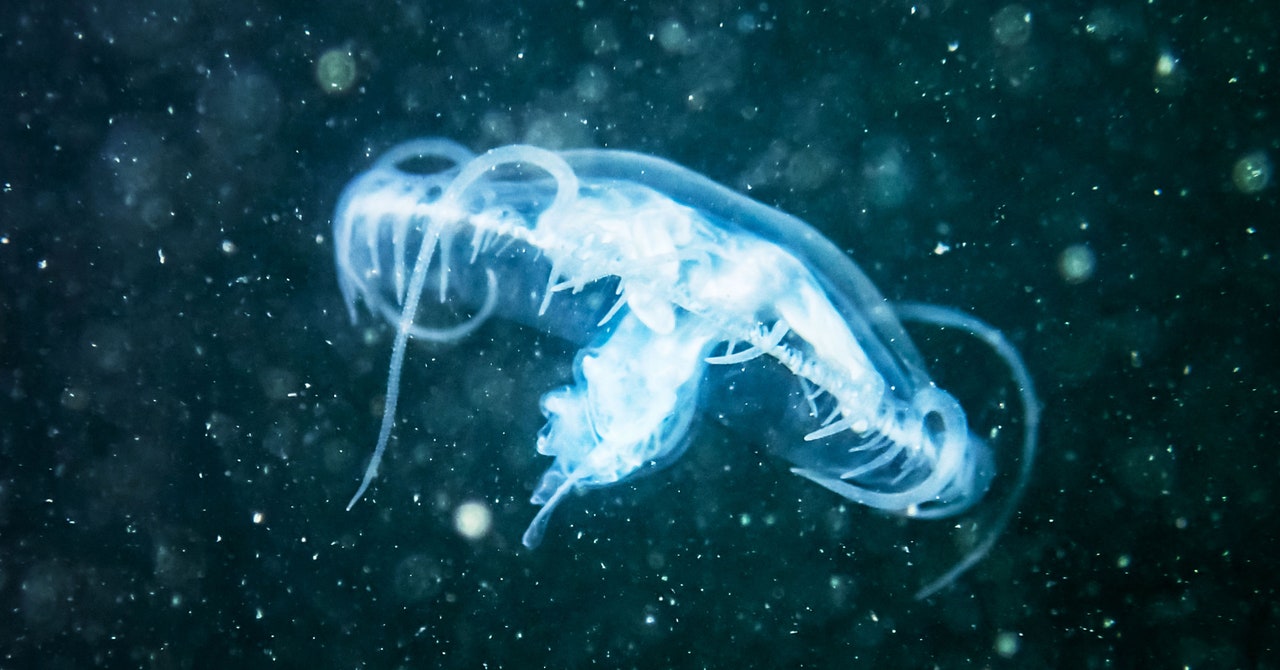
One 2020 sighting at the pond made it onto the United States Geological Survey’s Nonindigenous Aquatic Species database. Someone apparently spotted the jellies near a sandbar, between 50 and 150 feet offshore, suspended between three and 15 feet below the water’s surface.
That report classified the population as “established,” and it will probably remain that way: Once the jellies enter a waterway, they typically stay there. They have few natural predators, and while they need warm temperatures to bloom into medusas, the polyps and podocysts don’t require much hospitality; they can likely handle a New England winter, no problem. Because the jellies spend long spans of time basically invisible, evicting established populations is “virtually impossible,” Doller says. In places where saltwater jellyfish species interfere with fishing or get sucked into turbines, though, there’s major demand to do so. “I think if anybody could figure it out, they’d win a million bucks,” Doller says.
But he points out that, at Walden, the case for even attempting eradication is probably pretty weak. They’re able to sting, but can’t hurt humans. They eat zooplankton and other small creatures, but probably not so many that they’re cramping the lifestyle of local fish; writing in the Journal of Freshwater Ecology, fisheries researcher Dennis DeVries reported that C. sowerbyi appear to leave plenty of the of tiny drifters behind. “I don’t think they show up in such numbers that people should be worried about whether they’re stinging fish, eating eggs, eating insects,” Doller says.
When determining whether to pull out all the stops to wrangle and remove a non-native species, ecosystem managers typically consider three factors, says Ceci Weibert, an aquatic invasive species senior program specialist with the Great Lakes Commission. First, they assess whether the creature is harming the environment or dinging the economy. Next, they gauge population size and spread, to get a sense of whether its ranks are small or confined enough to feasibly be rounded up or taken out. Finally, they see whether they have the tools for the job—the right herbicide, pesticide, or mechanical process to get it done.
“Just because something is non-native, doesn’t mean it’s also going to be invasive,” Weibert says. According to a 2014 report from the National Oceanic and Atmospheric Administration, the Great Lakes house around 180 nonindigenous species, and fewer than a third of them, including the dreaded zebra mussel, have moderate-to-high environmental impacts. (The authors note that this could be an underestimate, though, since some species weren’t yet fully assessed.) Freshwater jellies scoot through that region, too, but the researchers don’t consider them a problem. They’re “just kind of living there and coexisting and causing relatively little impact,” Weibert says.
Doller says that there’s still a lot to learn about freshwater jellies, including the extent to which colonies expand, precisely how much food they consume, and whether we’re schlepping them from place to place. “It’s really hard to monitor and really hard to evaluate,” he says. “I don’t think enough is really known, but I don’t know that I would worry too much about them.”
Meanwhile, locals are pretty enchanted. “I love it when there’s really a cloud of jellyfish,” says Katherine Gogel, who has lived in the area on and off since 1968 and has visited the pond regularly since the 1990s, sometimes dropping by nearly every day. “It just makes me stop swimming. I hover there with them.” Gogel is transfixed by what she calls the jellies’ “pulse”—that gentle bunching and unfurling. Cookie Fisher-Martin, who lives in nearby Lincoln and has swam in the pond for around 20 years, first saw the jellies five or six years ago. Her brother pointed them out; she remembers him describing them as small, “like a little petal.” She has since spotted them in spring and fall, sometimes as tiny as the tip of her pinkie, sometimes the width of her thumb. Last year, she tried to scoop one into a plastic bag to take a closer look up on shore, but was foiled. “I really thought I had it in the bag, but when I got out, it was nowhere to be seen,” she says, laughing. “They’re like magicians.” Swimming alongside them can feel magical, too, in a way Thoreau might have appreciated. Paddling past large clusters, specks of white in the deep, dark blue, Fisher-Martin says, “you feel like you’re out in the stars.”
More Great WIRED Stories


